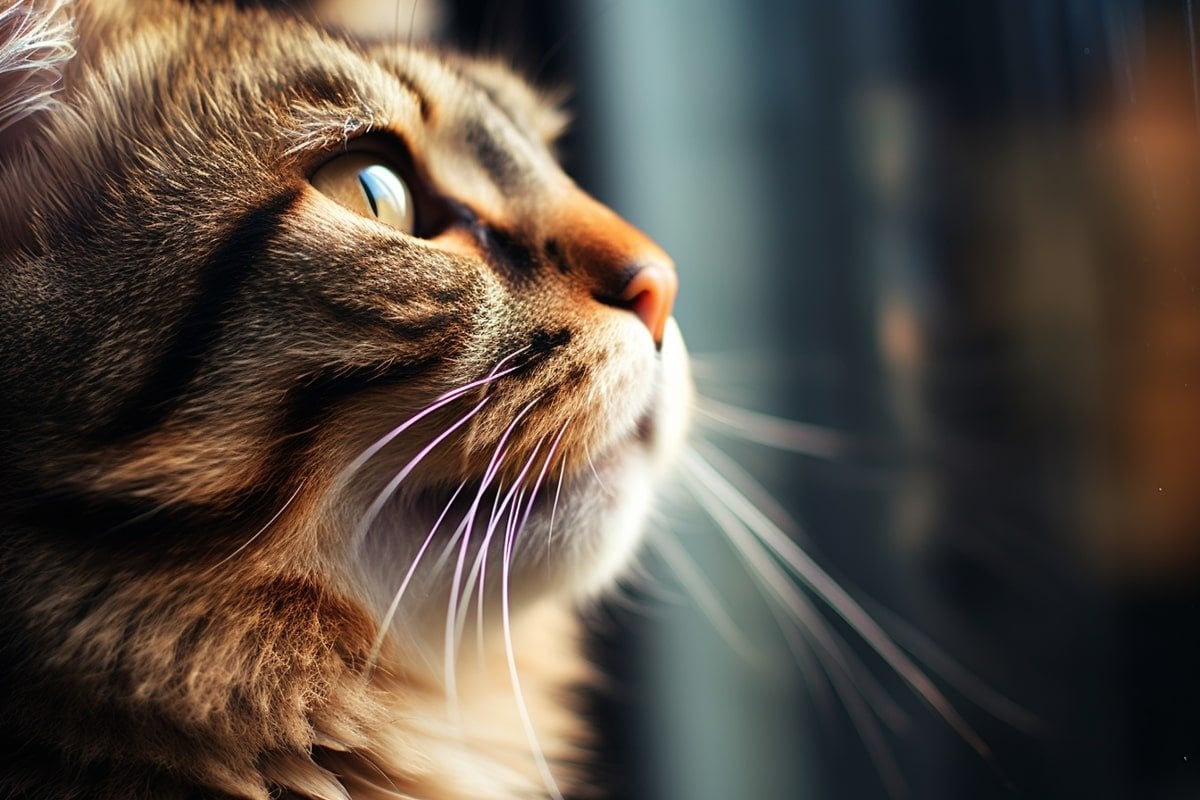Summary: Researchers have uncovered the intricate structure within a cat’s nose that aids in their exceptional olfactory abilities.
Through a 3D computer model and simulations, it was observed that inhaled air splits into two distinct streams within a cat’s nose, aiding both respiratory and olfactory functions. Notably, this research suggests that the feline nose operates much like a highly effective gas chromatograph.
The study’s findings could lead to advancements in the design of gas chromatographs used in labs today.
Key Facts:
- The researchers created a highly detailed 3D computer model of a cat’s nasal airway to study its flow patterns.
- The study revealed that inhaled air in a cat’s nose divides into two streams—one for respiration and another for odor detection, thus functioning similarly to a gas chromatograph.
- The cat’s nasal structure was found to be over 100 times more effective in odor detection compared to an amphibian-like straight nose.
Source: Ohio State University
Scientists have found the secret to felines’ finesse at sniffing out food, friends, and foes.
A complex collection of tightly coiled bony airway structures gets the credit, according to the first detailed analysis of the domestic cat’s nasal airway.
The researchers created a 3D computer model of the cat nose and simulated how an inhalation of air containing common cat food odors would flow through the coiled structures.

They found that the air separates into two flow streams, one that is cleansed and humidified and another delivering the odorant quickly and efficiently to the system responsible for smelling – the olfactory region.
In essence, the researchers suggest, the cat nose functions as a highly efficient and dual-purposed gas chromatograph – a tool that, in the laboratory, detects and separates chemicals in vaporized form. In fact, the cat nose is so efficient at this that its structure could inspire improvements to the gas chromatographs in use today.
While the long alligator nose has also been found to mimic gas chromatography, researchers theorize that the compact cat head drove an evolutionary change that resulted in the labyrinthine airway structure that not only fits, but helps cats adapt to diverse environments.
“It’s a good design if you think about it,” said Kai Zhao, associate professor of otolaryngology in Ohio State’s College of Medicine and senior author of the study.
“For mammals, olfaction is very important in finding prey, identifying danger, finding food sources and tracking the environment. In fact, a dog can take a sniff and know what has passed through – was it a friend or not?” he said.
“That’s an amazing olfactory system – and I think potentially there have been different ways to evolve to enhance that.
“By observing these flow patterns and analyzing details of these flows, we think they could be two different flow zones that serve two different purposes.”
The research is published today in PLOS Computational Biology.
Zhao’s lab has previously created models of the rat and human nose to study air flow patterns, but the high-resolution cat model and simulation experiments are his most complicated to date, based on micro-CT scans of a cat’s head and microscopic-level identification of tissue types throughout the nasal cavity.
“We spent a lot of time developing the model and more sophisticated analysis to understand the functional benefit that this structure serves,” he said. “The cat nose probably has a similar complexity level as the dog’s, and it’s more complex than a rodent’s – and it begs the question – why was the nose evolved to be so complex?”
Computer simulations of breathing revealed the answer: During a simulated inhalation, researchers observed two distinct regions of air flow – respiratory air that gets filtered and spreads slowly above the roof of the mouth on its way to the lungs, and a separate stream containing odorant that moves rapidly through a central passage directly to the olfactory region toward the back of the nasal cavity.
The analysis took into account both the location of flow and the speed of its movement through turbinates, the bony structures inside the nose.
“We measured how much flow goes through specific ducts – one duct that delivers most odorant chemicals into the olfactory region, versus the rest, and analyzed the two patterns,” Zhao said. “For respirant breathing, turbinates branch to divert flow into separate channels, sort of like a radiator grid in a car, which would be better for cleansing and humidifying.
“But you want odor detection to be very fast, so there is one branch that delivers odor at high speed, potentially allowing for quick detection rather than waiting for air to filter through the respiratory zone – you could lose most of the odor if air has been cleansed and the process is slowed down.”
The simulation also showed that the air shuttled to the olfactory region is then recirculated in parallel channels when it gets there. “That was actually a surprise,” Zhao said. “It’s like you take a sniff, the air is shooting back there and then is being processed for a much longer time.”
This study is the first to quantify the difference in gas chromatography between mammals and other species – Zhao and colleagues estimate the cat’s nose is more than 100 times more efficient at odor detection than an amphibian-like straight nose in a similarly sized skull – and to come up with a parallel gas chromatography theory: parallel olfactory coils feeding from the high-speed stream to increase the effective length of the flow path while slowing down the local airflow speed, potentially for better odor processing.
“We know so much about vision and hearing, but not so much about the nose. This work could lead to more understanding of the evolutionary pathways behind different nose structures, and the functional purpose they serve,” Zhao said.
Zhenxing Wu, a postdoctoral scholar in Zhao’s lab, is first author of the study. Additional co-authors include Jianbo Jiang and Fritz Lischka of Monell Chemical Senses Center in Philadelphia; Scott McGrane of Waltham Petcare Science Institute in the United Kingdom; and Yael Porat-Mesenco of the University of Pennsylvania.
Funding: This work was partly funded by the National Institutes of Health and Mars Petcare UK.
About this olfaction research news
Author: Emily Caldwell
Source: Ohio State University
Contact: Emily Caldwell – Ohio State University
Image: The image is credited to Neuroscience News
Original Research: Open access.
“Domestic cat nose functions as a highly efficient coiled parallel gas chromatograph” by Kai Zhao et al. PLOS Computational Biology
Abstract
Domestic cat nose functions as a highly efficient coiled parallel gas chromatograph
The peripheral structures of mammalian sensory organs often serve to support their functionality, such as alignment of hair cells to the mechanical properties of the inner ear.
Here, we examined the structure-function relationship for mammalian olfaction by creating an anatomically accurate computational nasal model for the domestic cat (Felis catus) based on high resolution microCT and sequential histological sections.
Our results showed a distinct separation of respiratory and olfactory flow regimes, featuring a high-speed dorsal medial stream that increases odor delivery speed and efficiency to the ethmoid olfactory region without compromising the filtration and conditioning purpose of the nose.
These results corroborated previous findings in other mammalian species, which implicates a common theme to deal with the physical size limitation of the head that confines the nasal airway from increasing in length infinitely as a straight tube.
We thus hypothesized that these ethmoid olfactory channels function as parallel coiled chromatograph channels, and further showed that the theoretical plate number, a widely-used indicator of gas chromatograph efficiency, is more than 100 times higher in the cat nose than an “amphibian-like” straight channel fitting the similar skull space, at restful breathing state.
The parallel feature also reduces airflow speed within each coil, which is critical to achieve the high plate number, while feeding collectively from the high-speed dorsal medial stream so that total odor sampling speed is not sacrificed.
The occurrence of ethmoid turbinates is an important step in the evolution of mammalian species that correlates to their expansive olfactory function and brain development.
Our findings reveal novel mechanisms on how such structure may facilitate better olfactory performance, furthering our understanding of the successful adaptation of mammalian species, including F. catus, a popular pet, to diverse environments.






